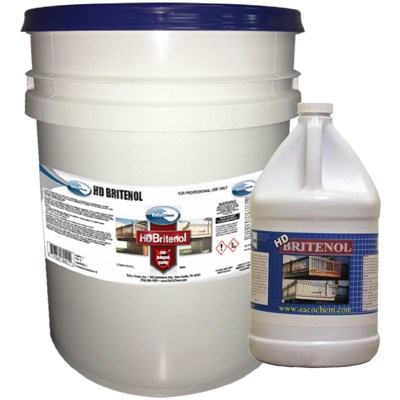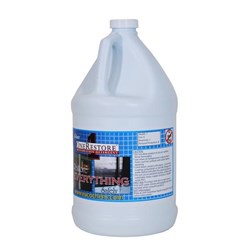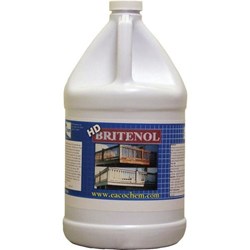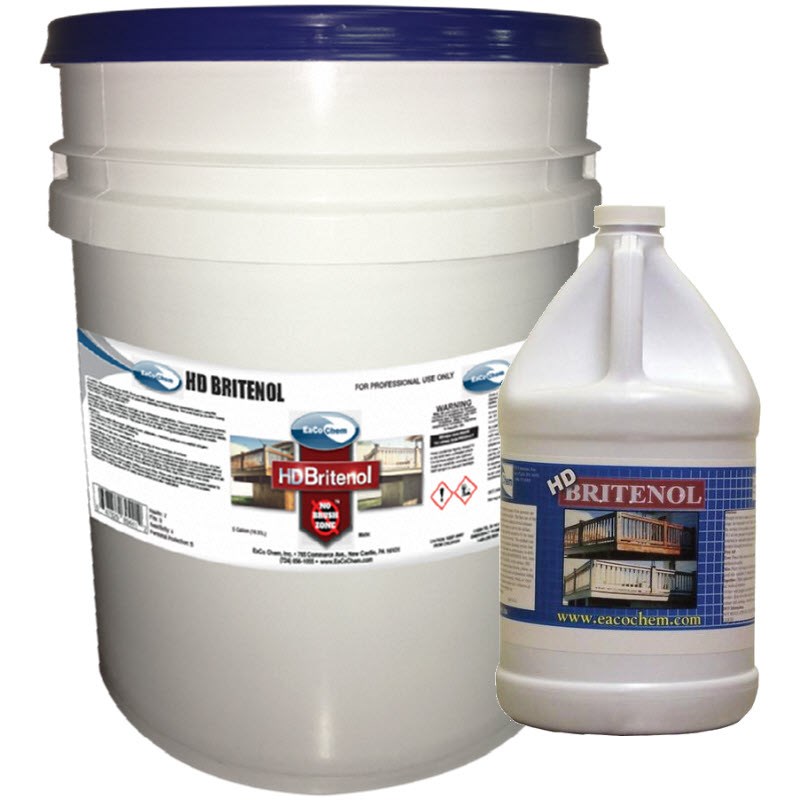EaCo Chem HD Britenol Restoration Cleaner
Quick Overview
- Britenol is an all purpose acidic cleaner designed to be used on homes and in commercial cleaning applications.
- Used to remove a variety of stains including hard water stains on of masonry, polished stone, limestone, fiberglass, tile, metal finishes, wood, painted aluminum, or vinyl siding.
- Designed to be used in two applications, spaced several minutes apart, without allowing the product to dry on the surface.
- Used as the first cleaner in two step (Britenol and then Cleansol) cleaning process that offers exceptional brushless cleaning results
- Used to remove a variety of stains including hard water stains on of masonry, polished stone, limestone, fiberglass, tile, metal finishes, wood, painted aluminum, or vinyl siding.
Show More
HD BRITENOL
All Purpose Mild-Acid Based Cleaner
- Britenol is designed to be used on a variety of masonry surfaces, sidings, polished stone surfaces, limestone and concrete.
- This acid blend has proven to be very effective at removing the stains that can occur under eaves on siding.
- Doesn't contain bleach, safe on skin.
- Can be used on wood or synthetic decks.
- Generally safe on anodized aluminum & glass. May harm coatings. Test small area first.
Advantages
- Safe on Skin
- 100% safe on glass
- Improves productivity

Paint Oxidation - The paint on the shutters oxidized and ran onto the siding.
Two applications of HD Britenol were used at 20:1 with a low pressure rinse to remove the oxidized paint run.

Dilutions
Suitable Substrates
- Aluminum Siding
- Vinyl Siding
- Stainless Steel (non-coated)
- Fiberglass
- Tile
- Porcelain
- Asphalt Shingles
- Stucco
- Wood
- Granite
- Unpolished marble
- Limestone
- Concrete
- EIFS
Pretesting is always recommended prior to full-scale cleaning
Britenol can be used on a variety of masonry surfaces, polished stone surfaces, limestone, fiberglass, tile, porcelain, metal finishes, concrete, wood, painted aluminum and vinyl siding.
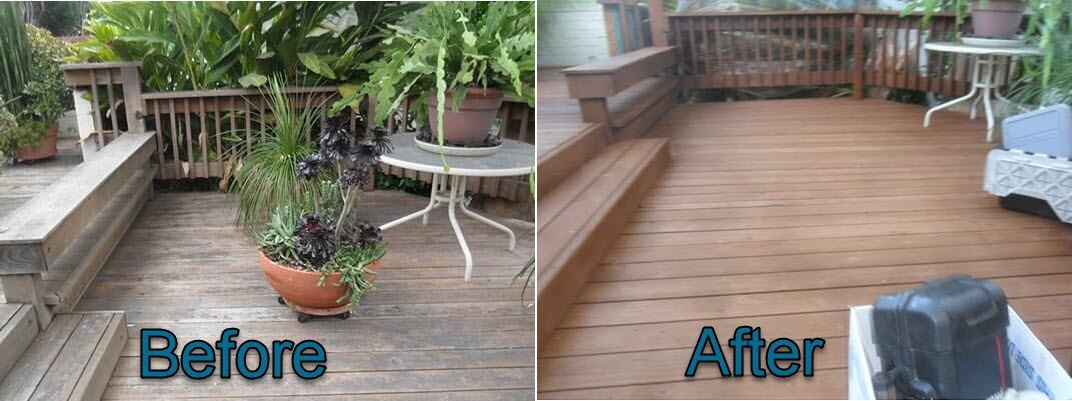
Redwood Deck - The most remarkable attribute of HD Britenol was being able to restore the wood to new while not causing any damage to the surrounding plants or surfaces. For removing the environmental stain, two applications of HD Britenol was used with a low pressure rinse with a wide fan nozzle to avoid damaging the wood.
HDBritenol works great on most substrates and will not harm people or animals when used as directed, however care should be taken to protect plants.
HD Britenol is sold as a concentrate and ships not regulated by the D.O.T.
Perform spot testing when unsure the surface you are cleaning is compatible.
The two-step system creates neutralization and will boost performance in difficult areas such as under eaves.
HD Britenol can be rinsed using cold water and low pressure.
Pressures that mark the surface should be avoided.
When in doubt, follow the manufacturers recommended P.S.I. for the substrates.

Polished Marble - The Ridgewood Savings Bank in Laurelton, NY is comprised of polished marble which can be as tricky to clean as polished granite. HD Britenol is a great choice for both surfaces since it won’t ruin the polished finish.
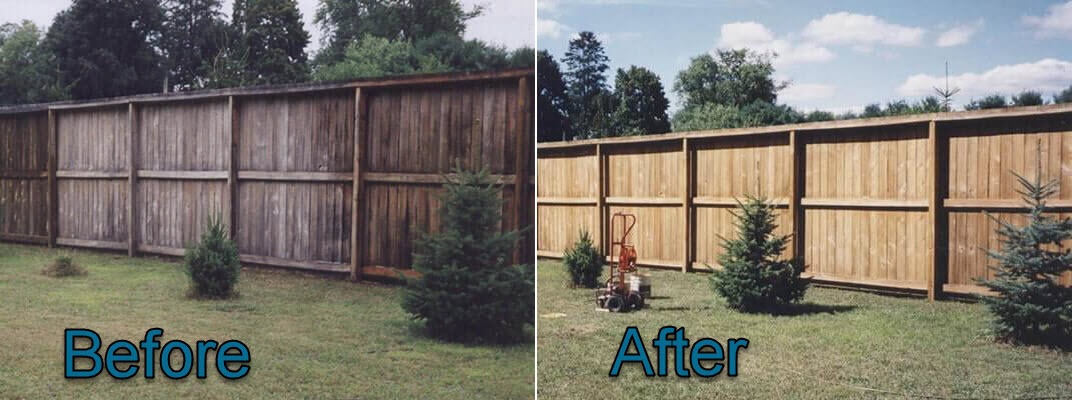
Wood Fence - HD Britenol removed the black environmental stains from this wooden fence.
Avoid direct contact with foliage, wet the foliage with water before and after cleaning.
Avoid wind drift on surrounding surfaces such as auto and pedestrian traffic.
Do not allow products to dry on the surface.
Always rinse thoroughly while still wet.
Safety Information
Do not wear contact lenses when using this product.
If material comes in contact with clothing, wash before re-use.
Do not dilute this product with any other product except clean water.
Do not use any other application other than specified in the application instructions.
Keep container closed when not in use.
Use with adequate ventilation.
Use NIOSH/ MSHA approved respiration devises when adequate ventilation is not available.
Though the potential for fuming is minimal, take precautions to avoid exposing building occupants to fumes.
Do not remove the label from the container.
Dispose of empty containers in accordance with federal, state, and local regulations
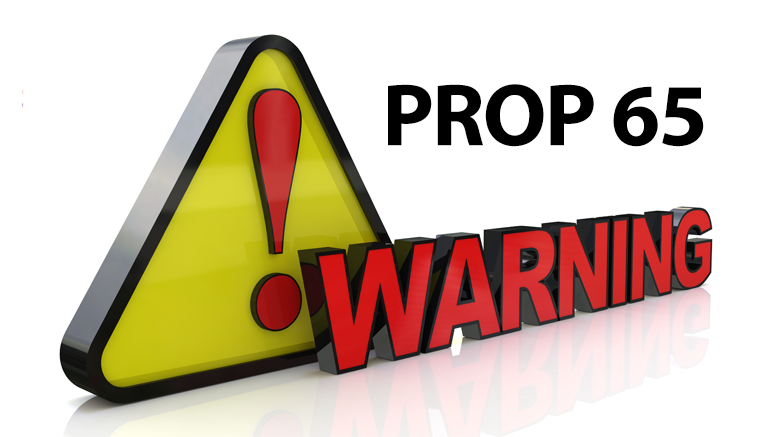
Proposition 65 requires businesses to provide warnings to Californians about significant exposures to chemicals that cause cancer, birth defects or other reproductive harm. These chemicals can be in the products that Californians purchase, in their homes or workplaces, or that are released into the environment. By requiring that this information be provided, Proposition 65 enables Californians to make informed decisions about their exposures to these chemicals. Proposition 65 also prohibits California businesses from knowingly discharging significant amounts of listed chemicals into sources of drinking water. Proposition 65 requires California to publish a list of chemicals known to cause cancer, birth defects or other reproductive harm. This list, which must be updated at least once a year, has grown to include approximately 900 chemicals since it was first published in 1987. Proposition 65 became law in November 1986, when California voters approved it by a 63-37 percent margin. The official name of Proposition 65 is the Safe Drinking Water and Toxic Enforcement Act of 1986.
The list of chemicals contains a wide range of naturally occurring and synthetic chemicals that include additives or ingredients in pesticides, common household products, food, drugs, dyes, or solvents. Listed chemicals may also be used in manufacturing and construction, or they may be byproducts of chemical processes, such as motor vehicle exhaust. For more information visit www.p65warnings.ca.gov/


